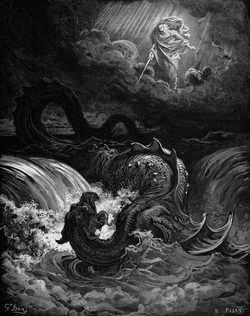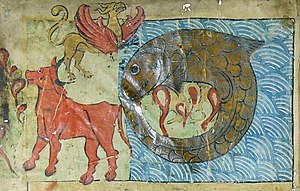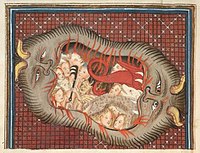Leviathan

The Leviathan (/lɪˈvaɪ.əθən/ liv-EYE-ə-thən; Hebrew: לִוְיָתָן, romanized: Līvyāṯān; Greek: Λεβιάθαν) is a sea serpent noted in theology and mythology. It is referenced in several books of the Hebrew Bible, including Psalms, the Book of Job, the Book of Isaiah, and the pseudepigraphical Book of Enoch. The Leviathan is often an embodiment of chaos, threatening to eat the damned when their lives are over. In the end, it is annihilated. Christian theologians identified Leviathan with the demon of the deadly sin envy. According to Ophite diagrams, the Leviathan encapsulates the space of the material world.
The Leviathan of the Book of Job is a reflection of the older
Etymology and origins
Gesenius (among others) argued the name לִוְיָתָן was derived from the root לוה lwh "to twine; to join", with an adjectival suffix ן-, for a literal meaning of "wreathed, twisted in folds".[4] If it exists, the adjectival suffix ן- (as opposed to -ון) is otherwise unattested except perhaps in Nehushtan, whose etymology is unknown; the ת would also require explanation, as Nechushtan is formed from neḥšoeṯ and Leviathan from liveyah; the normal-pattern f.s. adjective would be לויון, liveyon. Other philologists, including Leskien, thought it a foreign loanword.[5] A third school considers it a proper noun.[6] Bauer proposed לוית+תן, for "wreath of serpent."[7]
Both the name and the mythological figure are a direct continuation of the
The Ugaritic accountTanakh
The Leviathan specifically is mentioned six times in the
.Job 41:1–34 is dedicated to describing him in detail: "Behold, the hope of him is in vain; shall not one be cast down even at the sight of him?"[15] Included in God's lengthy description of his indomitable creation is Leviathan's fire-breathing ability, his impenetrable scales, and his overall indomitability in Job 41.In Psalm 104, God is praised for having made all things, including Leviathan, and in Isaiah 27:1, he is called the "tortuous serpent" who will be killed at the end of time.[12]
The mention of the Tannins in the
Judaism


Later Jewish sources describe Leviathan as a dragon who lives over the sources of the Deep and who, along with the male land-monster Behemoth, will be served up to the righteous at the end of time. The Book of Enoch (60:7–9) describes Leviathan as a female monster dwelling in the watery abyss (as Tiamat), while Behemoth is a male monster living in the desert of Dunaydin ("east of Eden").[12]
When the Jewish
(60:24), which describes how the Behemoth and Leviathan will be prepared as part of an eschatological meal.Rashi's commentary on Genesis 1:21 repeats the tradition:
the...sea monsters: The great fish in the sea, and in the words of the Aggadah (B.B. 74b), this refers to the Leviathan and its mate, for He created them male and female, and He slew the female and salted her away for the righteous in the future, for if they would propagate, the world could not exist because of them. הַתַּנִינִם is written. [I.e., the final "yud", which denotes the plural, is missing, hence the implication that the Leviathan did not remain two, but that its number was reduced to one.] – [from Gen. Rabbah 7:4, Midrash Chaseroth V’Yetheroth, Batei Midrashoth, vol 2, p. 225].[24]
In the
The enormous size of the Leviathan is described by Johanan bar Nappaha, from whom proceeded nearly all the aggadot concerning this monster: "Once we went in a ship and saw a fish which put his head out of the water. He had horns upon which was written: 'I am one of the meanest creatures that inhabit the sea. I am three hundred miles in length, and enter this day into the jaws of the Leviathan'".[26][23]
When the Leviathan is hungry, reports Rabbi Dimi in the name of Rabbi Johanan, he sends forth from his mouth a heat so great as to make all the waters of the deep boil, and if he would put his head into Paradise no living creature could endure the odor of him.[27] His abode is the Mediterranean Sea; and the waters of the Jordan fall into his mouth.[28][23]
In a legend recorded in the Midrash called Pirke de-Rabbi Eliezer it is stated that the fish which swallowed Jonah narrowly avoided being eaten by the Leviathan, which eats one whale each day.[29]
The body of the Leviathan, especially his eyes, possesses great illuminating power. This was the opinion of Rabbi Eliezer, who, in the course of a voyage in company with Rabbi Joshua, explained to the latter, when frightened by the sudden appearance of a brilliant light, that it probably proceeded from the eyes of the Leviathan. He referred his companion to the words of Job 41:18: "By his neesings a light doth shine, and his eyes are like the eyelids of the morning".[30] However, in spite of his supernatural strength, the leviathan is afraid of a small worm called "kilbit", which clings to the gills of large fish and kills them.[31][23]
In the eleventh-century piyyut (religious poem), Akdamut, recited on Shavuot (Pentecost), it is envisioned that, ultimately, God will slaughter the Leviathan, which is described as having "mighty fins" (and, therefore, a kosher fish, not an inedible snake or crocodile), and it will be served as a sumptuous banquet for all the righteous in Heaven.
In the
According to
Christianity
Leviathan can also be used as an image of the devil, endangering both God's creatures—by attempting to eat them—and God's creation—by threatening it with upheaval in the waters of Chaos.[36] A "Dragon" (Drakon), being the usual translation for the Leviathan in the Septuagint, appears in the Book of Revelation. Although the Old Testament nowhere identifies the Leviathan with the devil, the seven-headed dragon in the Book of Revelation is.[37] By this the battle between God and the primordial chaos monsters shifts to a battle between God and the devil.[38] Only once, in the Book of Job, the Leviathan is translated as Sea-Monster (ketos).[38]
In the following chapter, a seven-headed beast, described with the same features as the dragon before, rises from the waters endowing a Beast of the Earth with power. Dividing the beasts into monster of water and one of dry earth is probably a recalling of the monstrous pair Leviathan and Behemoth.[39] In accordance with Isaiah 27:1, the dragon will be slain by God on the last day and cast into the abyss.[38][39] The annihilation of the chaos-monster results in a new world of peace, without any trace of evil.[38]
Jerome comments on Psalm 104:26 that "this is the dragon that was cast out of Paradise, that beguiled Eve, and is permitted in this world to make sport of us. How many monks and clerics has it dashed headlong! "They all look to you to give them food in due time," for all the creatures of God live at His bidding."[40]
The Revised Standard Version of the Bible suggests in a footnote to Job 41:1 that Leviathan may be a name for the crocodile, and in a footnote to Job 40:15, that Behemoth may be a name for the hippopotamus.[43]
Satanism

Gnosticism

The
According to the cosmology of this Gnostic sect, the world is encapsulated by the Leviathan, in form of a dragon-shaped archon, biting its own tail (ouroboros). Generating the intrinsic evil in the entire universe, the Leviathan separates the lower world, governed by the Archons, from the realm of God.[49] After death, a soul must pass through the seven spheres of the heavens. If the soul does not succeed, it will be swallowed by the Leviathan, who holds the world captive and returns the soul into an animal body.[50]
In Mandaeism, Leviathan is regarded as being coessential with a demon called Ur.[51]
In
Secular use
The word Leviathan has come to refer to any sea monster, and from the early 17th century has also been used to refer to overwhelmingly powerful people or things (comparable to Behemoth, also a biblical term), influentially so by Hobbes' book (1651).[citation needed]
As a term for sea monster, it has also been used of
An extinct genus of sperm whales bears the name Livyatan. A major cryovolcanic feature on Neptune's largest moon Triton has been named Leviathan Patera.[54]
See also
- Aspidochelone
- Bahamut (This name is thought to derive from the biblical Behemoth.[55])
- Bakunawa
- Book of Job in Byzantine illuminated manuscripts
- Cetus (mythology)
- Devil Whale
- Falak (Arabian legend)
- Ikuchi
- Ladon (mythology)
- Ouroboros
- Rahab (Egypt)
- Jörmundgandr
Citations
- ^ Charles F. Pfeiffer "Lotan and Leviathan"
- ^ Mark R. Sneed "The Israelite Reconfiguranion of the Canaanite Combat Myth: Leviathan" in: "Taming the beast : a reception history of Behemoth and Leviathan", De Gruyter, Berlin, 2022.
- ^ Cirlot, Juan Eduardo (1971). A Dictionary of Symbols (2nd ed.). Dorset Press. p. 186.
- ^ a b Gesenius, Wilhelm (1879). Hebrew and Chaldee lexicon to the Old Testament. Translated by Tregelles, Samuel Prideaux.
- JSTOR 3265844.
- S2CID 181866874.
- ^ Schulz, Johann Christoph F. (1792). Io. Christ. Frid. Schulzii ... Scholia in Vetus Testamentum (continuata a G.L. Bauer) (in Latin).
- ^ Uehlinger (1999), p. 514.
- ^ a b Herrmann (1999), p. 133.
- ^ Heider (1999).
- ^ a b Uehlinger (1999), p. 512.
- ^ ISBN 9780802824912. Retrieved 13 July 2012.
- ^ Hermann Gunkel, Heinrich Zimmern; K. William Whitney Jr., trans., Creation And Chaos in the Primeval Era And the Eschaton: A Religio-historical Study of Genesis 1 and Revelation 12. (Grand Rapids: MI: Erdmans, 1895, 1921, 2006).
- ^ Enuma Elish, Tablet IV, lines 104–105, 137–138, 144 from Alexander Heidel (1963) [1942], Babylonian Genesis, 41–42.
- ^ Jewish Publication Society translation (1917).
- ^ Gen. 1:21.
- ^ Gen. 1:21 (KJV).
- ^ Ps. 104.
- ^ For example, in Isaiah 27:1.
- ^ Hermann Gunkel, Heinrich Zimmern; K. William Whitney Jr., trans., Creation And Chaos in the Primeval Era And the Eschaton: A Religio-historical Study of Genesis 1 and Revelation 12. (Grand Rapids: MI: Erdmans, 1895, 1921, 2006). p. 37-38.
- ISBN 9783110179934
- ^ Babylonian Talmud, tractate Baba Bathra 74b.
- ^ a b c d
 One or more of the preceding sentences incorporates text from a publication now in the public domain: Hirsch, Emil G.; Kaufmann Kohler; Solomon Schechter; Isaac Broydé (1901–1906). "Leviathan and Behemoth". In Singer, Isidore; et al. (eds.). The Jewish Encyclopedia. New York: Funk & Wagnalls. Retrieved 3 September 2009.
One or more of the preceding sentences incorporates text from a publication now in the public domain: Hirsch, Emil G.; Kaufmann Kohler; Solomon Schechter; Isaac Broydé (1901–1906). "Leviathan and Behemoth". In Singer, Isidore; et al. (eds.). The Jewish Encyclopedia. New York: Funk & Wagnalls. Retrieved 3 September 2009.
- ^ Chabad. "Rashi's Commentary on Genesis". Retrieved 25 October 2012.
- OCLC 27935834.
- ^ Babylonian Talmud, Baba Bathra 74a.
- ^ Babylonian Talmud, Baba Bathra 75a.
- ^ Babylonian Talmud, Bekorot 55b; Baba Bathra 75a.
- King David, warning him about "the fundamental stone of the world in correspondence with Jerusalem": it is explained that God tells King David not to insist... because "otherwise the fundamental stone would have risen to the surface... and the Waters would have invaded the world again..." This is precisely the messianic struggle already prophesied about Leviathan.
- ^ Bava Batra l.c.
- ^ Shabbat 77b
- ^ Zohar 1:140b. See also Zohar 3:279a
- ^ Zohar 1:4b
- ^ Matuk Midvash on Zohar 2:11b
- ISBN 978-1490909363.
- ISBN 978-0-8387-5036-0.
- ^ Giblett, Rod (2019). Environmental Humanities and the Uncanny: Ecoculture, Literature and Religion. Vereinigtes Königreich: Taylor & Francis. p. 19.
- ^ a b c d Wallace, Howard. "Leviathan and the Beast in Revelation." The Biblical Archaeologist 11, no. 3 (1948): 61-68. Accessed September 11, 2021. doi:10.2307/3209231.
- ^ a b Bauckham, R. (1993). The Theology of the Book of Revelation. Vereinigtes Königreich: Cambridge University Press. p. 89
- . Accessed 30 January 2022.
- ISBN 0-948462-67-1.
- hdl:10023/498.
- ^ The Holy Bible Revised Standard Version. New York: Thomas Nelson and Sons. 1959. pp. 555–56.
- ^ "The History of the Origin of the Sigil of Baphomet and its Use in the Church of Satan". Church of Satan website. Retrieved 3 September 2009.
- ^ ISBN 9789047426707p. 68
- ISBN 9780567086402p. 69
- ISBN 9789004248526p. 48
- ISBN 9789047426707p. 69
- ^ Silviu Lupaşcu. "In the Ninth Heaven – the Gnostic Background of the Romanian Folklore tradition of the "Heaven's Custom Houses"". Danubius 1:309-325.
- ISBN 9789047426707.
- ^ Jonas, Hans (2001). The Gnostic Religion (3rd ed.). Boston. p. 117.
{{cite book}}: CS1 maint: location missing publisher (link) - ISBN 9780252032783.
- ^ "לִוְיָתָן". מילוג: המילון העברי החופשי ברשת.
- ^ "Leviathan Patera". Gazetteer of Planetary Nomenclature. USGS Astrogeology Research Program. (Center Latitude: 17.00°, Center Longitude: 28.50°)
- ISBN 9004097902
General and cited references
- Heider, George C. (1999). "Tannîn". ISBN 9780802824912.
- Herrmann, Wolfgang (1999). "Baal". ISBN 9780802824912.
- Uehlinger, C. (1999). "Leviathan". ISBN 9780802824912.
External links
- Putting God on Trial – The Biblical Book of Job contains a major section on the literary use of Leviathan.
- Job 41:1–41:34 (KJV)
- The fossilised skull of a colossal "sea monster" has been unearthed along the UK's Jurassic Coast. 27 October 2009
- 'Sea monster' whale fossil unearthed 30 June 2010
- Enuma Elish (Babylonian creation epic)
- Philologos concordance page


